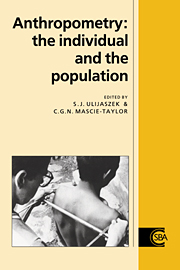Book contents
- Frontmatter
- Contents
- List of contributors
- Preface
- Acknowledgements
- 1 The place of anthropometry in human biology
- 2 Asymmetry and growth
- 3 Intra- and inter-observer error in anthropometric measurement
- 4 Statistical issues in anthropometry
- 5 Statistical constructs of human growth: new growth charts for old
- 6 Growth monitoring and growth cyclicities in developed countries
- 7 Growth monitoring, screening and surveillance in developing countries
- 8 Variability in adult body size: uses in defining the limits of human survival
- 9 Anthropometry and body composition
- 10 Anthropometry and physical performance
- 11 Anthropometry, strength and motor fitness
- 12 Anthropometry in the US armed forces
- Index
8 - Variability in adult body size: uses in defining the limits of human survival
Published online by Cambridge University Press: 19 November 2009
- Frontmatter
- Contents
- List of contributors
- Preface
- Acknowledgements
- 1 The place of anthropometry in human biology
- 2 Asymmetry and growth
- 3 Intra- and inter-observer error in anthropometric measurement
- 4 Statistical issues in anthropometry
- 5 Statistical constructs of human growth: new growth charts for old
- 6 Growth monitoring and growth cyclicities in developed countries
- 7 Growth monitoring, screening and surveillance in developing countries
- 8 Variability in adult body size: uses in defining the limits of human survival
- 9 Anthropometry and body composition
- 10 Anthropometry and physical performance
- 11 Anthropometry, strength and motor fitness
- 12 Anthropometry in the US armed forces
- Index
Summary
Introduction
Human body size may be surveyed from three standpoints: (i) measurement of height or stature (which is one-dimensional); (ii) measurement of surface area (which is two-dimensional); and (iii) measurement of ponderal growth or weight (which is three-dimensional). Of the three, weight and height measurements are widely used to quantify the dynamic state of human growth. Although the assessment of body size has been extensively used to quantitatively describe nutritional status in children (Waterlow, 1972) there is little information for its use in defining the lower limits of human survival in adults. James, Ferro-Luzzi & Waterlow (1988) attempted to define chronic energy deficiency (CED) in adults in terms of their body mass index (BMI) and basal metabolic rate (BMR). This novel approach based its definition of CED on specific physiological criteria rather than the socioeconomic status of the individual. The authors proposed three cut-off points based on BMI: 18.5, 17 and 16. Subjects with BMI above 18.5 were classified as normal and below 16 as grade III CED. Although BMI alone was used to classify CED at the two extremes, it was combined with BMR values to define various degrees of grades I and II CED. The paper also proposed that a BMI of 12 may be the absolute lower limit compatible with life. A considerable body of information exists on the relationship between BMI and health in affluent societies (James, 1984; Garrow, 1981; Keys, 1980; Waaler, 1984). Much of the discussion has centred around the range and upper limits of BMI compatible with health.
- Type
- Chapter
- Information
- AnthropometryThe Individual and the Population, pp. 117 - 129Publisher: Cambridge University PressPrint publication year: 1994
- 5
- Cited by



